Bean curd skin is seriously an Asian specialty. It is a food product made from soybeans. The process involves boiling the soy milk in a shallow pan, a film of skin forms on the top of the soy milk. This film is removed and dried to become a thin yellowish sheet. It is a popular food item in China, Japan, and Korea.
Since this food item is relatively unfamiliar in the western world, it is translated in several ways based on its look and origin. Hence, beancurd sheets, fresh tofu skins, tofu sticks, soybean skin, bean curd sticks, yuba skin are referred to as the same item. However, I try to make things simpler by referring it as 腐竹 (fǔzhú or fu zhu,) which means tofu bamboo in Chinese. You can get it at most Asian markets or Asian grocery stores. Just show these two Chinese characters to the storekeeper to purchase, and he will not confuse them with other tofu-related products.
This beancurd skin recipe is typical among the Chinese living in southern China and the Asian region, albeit with variations of the method and ingredients. Below is my interpretation best to suit my palate, and I will mention some variations along the way for your consideration. Beancurd skin is a popular alternative to meat as it has a meaty texture.
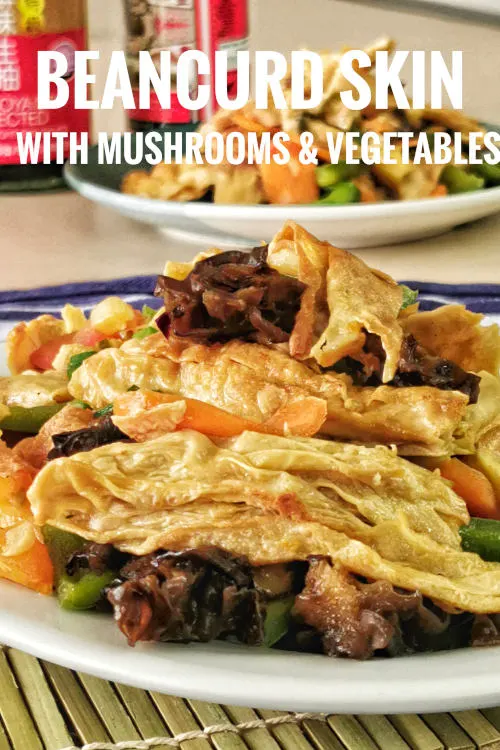
Note: This post may contain affiliate links. Please read my privacy policy for more info. I may receive commissions for purchases made through links in this post. As an Amazon Associate, I earn from qualifying purchases.
1. Prepare the beancurd skin – soaking and pan-frying
Here is the image for the beancurd skin I purchased. There are two main types of beancurd skin. The first type is what I used, which is in the form of sticks. I prefer using this type in this recipe. This is because I can cut it into pieces of equal size easily. The second type is large sheets of tofu skin, suitable in another recipe called Buddha’s delight. You can get the recipe for this vegetarian dish here.
Here are the steps:
- Cut the beancurd skin 2-inches section. Please be gentle as it is very brittle.
- Place the tofu skin sticks in a large bowl of cold water and soak until soft. The endpoint is when they are soft and no longer feel difficult to bend. Remove them from water and let them drain in a colander when this texture is achieved. They will start to break into small pieces if you leave them in the water after absorbing more water.
- Bring a pot of water to a boil, then blanch the beancurd skin briefly, say fifteen seconds, and remove immediately. This step will remove the unwanted smell and sand that might still adhere to it.
- Place them in cold water, and drain.
- Next, mix a beaten egg with a large tablespoon of cornstarch or tapioca flour to form a thick slurry. Place the drained beancurd skins into the egg mixture to coat each of them evenly.
- Now you can either deep-fry or pan-fry the beancurd skins. The cook in the restaurant prefers to deep-fry as it takes a much shorter time to finish a large batch of fried beancurd skins. However, a more practical (and healthier) way to do it at home is using a non-stick pan to pan-fry with little oil. In this case, drain off the excess egg batter, then shallow fry them single-layered in a non-stick pan with some hot oil until both sides turn golden brown. After that, remove from heat and set aside.
Note: Since the quality and thickness of various tofu skin are different, the time required to soak them can vary substantially. There are recipes suggesting soaking for two to three hours, but in my case, it only took half an hour to achieve the desired texture. It is also essential to use only cold water as hot water, or warm water will soften the outer layer of the beancurd skin quickly while the inner layers are still firm.
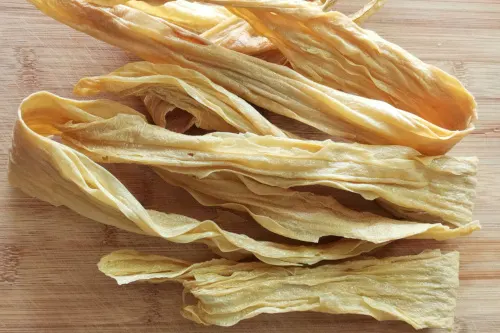
2. Other ingredients for the Chinese beancurd skin recipe
Other main ingredients besides the tofu skin are black fungus, shiitake mushrooms, and bell pepper. Here are my picks for the ingredients for this dish. I make it meat-free, but you can choose to include some meat. Stir-fry pork belly slices are one of the common choices.
- Black fungus (木耳 / wood ear mushroom) is an edible fungus with a distinguished ear-like shape and therefore is also called the wood ear. It is dark brown and has a chewy-crunchy texture. You need to rehydrate the fungus before use, and it will expand to a few times its original size. After that, remove the stem of the fungus, which is tough, and cut them into smaller pieces for use later.
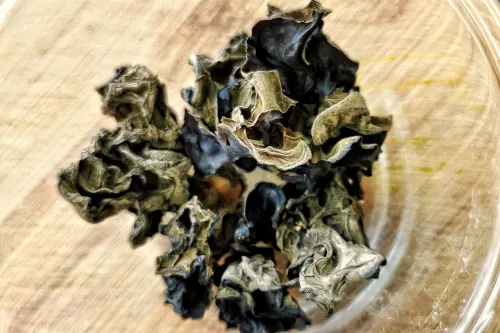
- Dried shiitake mushrooms need to rehydrate like the wood ear but take longer to turn soft. Remove the stem and then cut it into thick slices. Dried shiitake mushrooms are often used in different Chinese, vegetarian dishes due to their aroma and flavor. However, you may use other mushrooms as an alternative. For example, many restaurants in Malaysia use shimeji mushroom, which is widely available.
- Cut green bell pepper into half-inch pieces. You can use red and green chili as the substitute if you like it spicier.
- Slice a small carrot diagonally. Carrot contributes flavor and also brightens up the color of the dish.
- Cut a medium-sized tomato into small cubes. The tomato will disintegrate while cooking, turning into puree partially and flavoring the tofu skin.
- Cut the spring onion into two sections. The white part should be in thin slices for sauteing, and the green section for stir-frying in the last minute of cooking.
- Other ingredients suitable to include in this recipe are bok choy, water chestnuts, green beans, snow peas, and bamboo shoots.
- Cut a few cloves of garlic into thin slices. Some recipes also include fresh ginger slices, but I prefer more garlic.
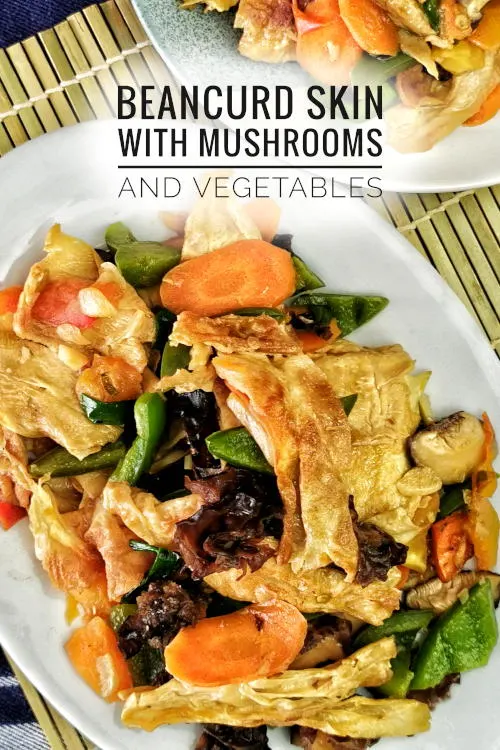
3. The cooking process
The stir-fry process is quick and easy, taking less than ten minutes to complete.
- Heat some peanut oil in a wok or large skillet over medium heat.
- Saute the garlic slices for half a minute or until it turns aromatic. Then add the white section of the spring onions and continue sauteing.
- Next, add the carrot, mushrooms, wood ear, and tomatoes. Let it cook for a minute until the tomato starts to disintegrate.
- Add the bell pepper, and then season with light soy sauce, sugar, salt, and white pepper. I also add some oyster sauce, which is my preference. You can turn it into a vegetarian dish by omitting the oyster sauce and using more light soy sauce and sugar.
- Return the fried beancurd sticks to the wok, and mix with the rest of the ingredients.
- Add half a cup of water and continue cooking until the bean curd sheets become soft. (do a taste test!) You may need more water since the beancurd skin can absorb plenty of water.
- Lastly, add the green section of the spring onion and a teaspoon of sesame oil before dish out. The flavor of sesame oil is quite sensitive to heat, and therefore it is best to add it at the last moment, or better with the stove turned off.
4. Other variations of beancurd skin recipes
Another popular way to serve the fried tofu skin sheets is to doused in a spicy sauce. This spicy tofu skin salad sauce usually consists of chili oil, black vinegar, and fermented broad bean paste. This cold Asian salad is a popular Szechuan dish called 凉拌 in Chinese, which means cold-mixed salad. I will attempt to make it in the future as I am a fan of spicy Szechuan food.
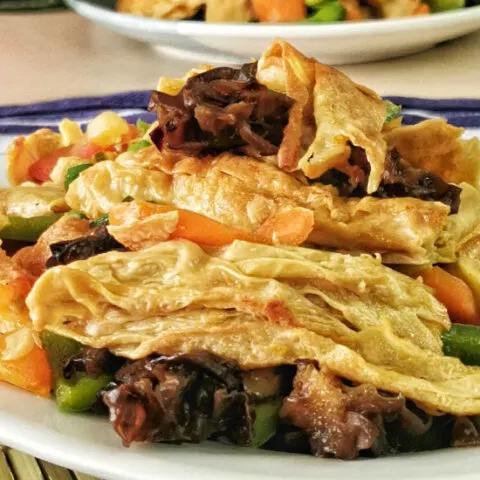
Beancurd skin recipe - How to stir-fried with mushrooms
This beancurd skin recipe is typical among the Chinese living in southern China and the Asian region.
Ingredients
- 100g beancurd skin (dry weight)
- 1 egg, beaten
- 1 tbsp cornstarch
- 4 dried shitake mushrooms, medium size
- 4 cloves of garlic, cut into slices
- 2 stalk spring onions
- 10g black fungus (dry weight)
- 1 small carrot, cut into slices
- 1 medium-size tomato, cut into cubes
- 1 medium size green bell pepper, cut into wedges
- 1 tsp sesame oil
- 1 tsp salt
- 1 tsp sugar
- 1 tbsp oyster sauce (optional)
- 1/4 tsp ground white pepper
- 3 tbsp peanut oil (for frying)
Instructions
Preparation
- Cut the beancurd skin into 2-inches sections.
- Place the tofu skin sticks in a large bowl of cold water and soak until soft. The endpoint is when they are soft and no longer feel difficult to bend.
- Blanch the beancurd skin boiling water for fifteen seconds, and remove immediately. Place them in cold water, and drain.
- Mix a beaten egg with the cornstarch to coat each beancurd skin evenly.
- Pan-fry the beancurd skins until both sides turn golden brown. Set aside.
- Soak the black fungus and dried shiitake mushrooms until soft. Cut the fungus into small pieces and mushrooms into thick slices.
- Cut green bell pepper into half-inch pieces.
- Slice a small carrot into slices diagonally.
- Cut a medium-sized tomato into small cubes.
- Cut the spring onion into two sections. The white part should be in thin slices for sauteing, and the green section for stir-frying in the last minute of cooking.
Cooking
- Saute the garlic slices in peanut oil for half a minute.
- Then add the white section of the spring onions and continue sauteing.
- Next, add the carrot, mushrooms, wood ear, and tomatoes.
- Add the bell pepper, then season with light soy sauce, oyster sauce, sugar, salt, and white pepper.
- Return the fried beancurd sticks to the wok, add half a cup of water and continue cooking until the bean curd sheets become soft.
- Lastly, add the green section of the spring onion and a teaspoon of sesame oil before dish out.
Recommended Products
As an Amazon Associate and member of other affiliate programs, I earn from qualifying purchases.
-
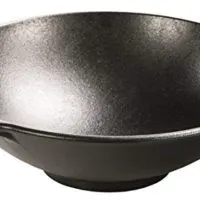 Lodge 14 Inch Cast Iron Wok. Pre-Seasoned Wok with Flattened Bottom for Asian Stir Fry and Sautees
Lodge 14 Inch Cast Iron Wok. Pre-Seasoned Wok with Flattened Bottom for Asian Stir Fry and Sautees -
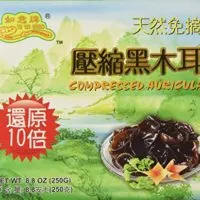 Premium Dried All Natural Compressed Chinese Auricularia Black Fungus Mushroom (Black Wood Ear Mushroom) - 8.8 Oz -- 10 Times Volume Yield After Soaking
Premium Dried All Natural Compressed Chinese Auricularia Black Fungus Mushroom (Black Wood Ear Mushroom) - 8.8 Oz -- 10 Times Volume Yield After Soaking -
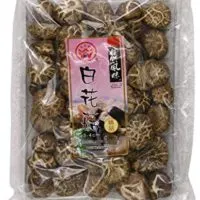 Havista Dried Premium Flower Shiitake Mushrooms, 6 Ounce
Havista Dried Premium Flower Shiitake Mushrooms, 6 Ounce -
 Dried Beancurd Sticks, Non-Gmo Soybean Curd Skin, Natural Asian Tofu, Dried Yuba for Vegan, Good Source Of Protein (17.6oz/500g) (17.6)
Dried Beancurd Sticks, Non-Gmo Soybean Curd Skin, Natural Asian Tofu, Dried Yuba for Vegan, Good Source Of Protein (17.6oz/500g) (17.6)
Nutrition Information:
Yield: 3 Serving Size: 1Amount Per Serving: Calories: 216Total Fat: 17gSaturated Fat: 3gTrans Fat: 0gUnsaturated Fat: 13gCholesterol: 62mgSodium: 985mgCarbohydrates: 14gFiber: 3gSugar: 5gProtein: 4g
This data was provided and calculated by Nutritionix on 2/27/2022

Felisha
Friday 27th of September 2024
Great recipe! Can the bean curd be batter, fried ahead of time, and added to the dish later when making it?
KP Kwan
Saturday 28th of September 2024
Yes, it can be kept after frying and kept. It's a good idea to prepare it this way.
Fumei
Sunday 1st of September 2024
This tasted as good as it looks! Great dish to keep in rotation.
ms
Thursday 22nd of August 2024
Excellent recipe--I like mine with a little more sauce so about another TBSP of soy did the trick. Thanks for a great recipe
KP Kwan
Saturday 24th of August 2024
Thank you for your input on improving the recipe!
Leah
Monday 29th of August 2022
Made this tonight. Added bok choy and fresh mushrooms with the dried. Have been looking for a bean curd skin recipe. It was very good. Thank you
K
Tuesday 1st of March 2022
This looks delicious - I really love tofu skin but haven't cooked much with it at home. I'm always happy to get inspiration for what to do with ingredients that I enjoy but haven't used often.